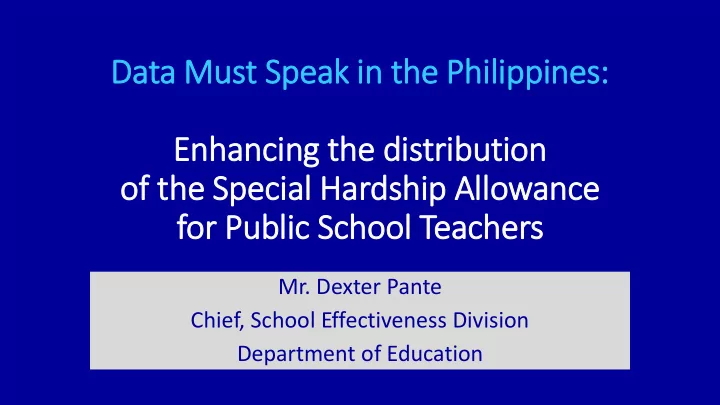

Data Must Speak in in the Philippines: Enhancing the dis istribution of the Special Hardship All llowance for Public School Teachers Mr. Dexter Pante Chief, School Effectiveness Division Department of Education
Diverse Situations and Challenges in Philippines ….
Public Schools in in the Phil ilippines Distribution of Elementary and Elementary Schools: Distance to Secondary Schools District / Division, Travel Time & Cost Private Mean Std. Dev. Secondary Schools, Distance to Division 6,969 , 10% 58 65 (km) Public Secondary • Travel Time (hrs) 2.2 9.1 Schools, 8,802 , 13% • Travel Cost (PhP) 149 337 Public Private Elementary, Distance to District (km) Elementary, 38,843 , 11 24 12,790 , 58% 19% • Travel Time (hrs) 0.7 2.5 • Travel Cost (PhP) 61 190
Background • DepEd identified need for the effective use of data to enhance equity in services and programmes, and agreed on UNICEF technical assistance partnership (Data Must Speak project) – Early 2016 • Data Must Speak project officially launched April 2016 • DepEd identified the need to update the Special Hardship Allowance for teachers among others • 1966 Magna Carta for Public School Teachers: • provides for a Special Hardship Allowance (SHA) for teachers exposed to hardship (e.g. difficulty in commuting / other hazards peculiar to work place) of at least 25% of their monthly salary. • National Budget Circular 514 (2007) • Grants Special Hardship allowance to school teachers and heads in hardship posts (priority), multi-grade teachers, mobile teacher, and ALS coordinators • Hardship posts are characterized by: Transport Inaccessibility and Difficulty of Situation: calamity, hazards to life, inconvenience of travel
Rationale • Despite the existing SHA policy, hardship posts still lack experienced teachers. • SHA, calculated at district level, is not always consistent with policy and appears to be an ineffective incentive as it does not incorporate many hardships experienced by teachers • Variations in implementation at local level • Based almost exclusively on distance • Mismatches between distance and rate • Rate depending on teacher level rather than distance • All teachers receiving the same amount regardless of base salary • Non-teaching staff receiving SHA.
Obje jectives • To mitigate the lack of teachers, especially experienced teachers, in hardship posts (addressing inequity in access and quality) • Consider various factors contributing to teacher hardship • Develop a Teacher Hardship Index that captures various factors in a single measure in a statistically sound and objective manner • Identify hardship posts • Translate Index to commensurate SHA • Estimate budgetary requirement for revised SHA • Review and inform the SHA policy
Strategies/Approaches • Formation of DMS Technical Working Group (TWG) with relevant DepED staff (DepEd Units involved: Planning, EBEIS, School Effectiveness, HR, Finance, Learning Delivery) • Consultations with Teachers in Manila and Region XII to identify factors that contribute to Teacher Hardship • On-line survey of teachers to identify and rank hardship factors • Analyze DepEd data from the Basic Education Information System and Philippine Statistical Authority to identify the determinants of hardship (measured by lack/shortage of experienced teachers in schools) • Develop composite index that combines identified sources of hardship and available data sources to calculate a hardship score (0-1) for each school. • Field testing of the Teacher Hardship Index in a selected DepED division
What consists of “Hardship” and How Much? No internet Temporary learning No water 4% spaces needed 4% 2% Human Violence No electricity 14% 7% Travel Cost Poverty incidence to Division 7% 14% Travel Time to Division 48% Teacher Hardship Index
Teacher Hardship In Index (c (continuous) and corresponding Special Hardship Allowance Teacher # of # of Number of Schools receiving SHA 5,396 Hardship SHA recipient recipient Elementary schools 4,839 Index amount Schools Staff High schools 557 0.35 – 0.39 10% 2497 21849 Number of staff receiving SHA 44,610 Elementary schools 34,149 0.4 – 0.49 15% 1253 9881 High schools 10,461 0.5 – 0.59 20% 731 5297 Total amount (millions) 1,586 0.6 up 25% 1005 7583 Elementary schools amount • (millions) 1,227 Up to 15% of public elementary schools and 7% of public secondary schools will benefit from the High schools amount (millions) 360 Special Hardship Allowance. • Enhanced distribution will be based on more objective formula and more equitable considering various hardships experienced by schools.
Next xt Steps • Present to DepEd Executive Committee • Discuss with Department of Budget and Management (DBM) suggested amendments on the NBC. Circular. • Develop and Issue policy • Communication with to the field offices • Quality assurance of the data • Re-assessment and adjustment of the Index • Impact Evaluation • DMS project to support automation of School Report Cards
Salamat!
Recommend
More recommend